Revisiting The OnePlus 3: sRGB, Memory Management, & More
by Brandon Chester on June 30, 2016 3:00 PM EST- Posted in
- Smartphones
- OnePlus
- OnePlus 3
Display Accuracy
As I mentioned in my initial review, the OnePlus 3 targets the NTSC color gamut. I really feel the need to reiterate that this choice of gamut target makes absolutely no sense. The actual NTSC gamut was never really relevant, even back in the 1950s when it was created. This is because the phosphors used in CRT displays of the time simply could not produce such saturated colors with an adequate brightness level. In fact, most modern displays still cannot realize the original NTSC gamut. Because of this, it was assumed that content was created and should be displayed using the gamut defined by the SMPTE C specification, which is actually smaller than the sRGB gamut. SMPTE C also used CIE Illuminant D65 for the white point instead of CIE Standard Illuminant C which has a CCT of 6774K, making it more blue than the white point used in more modern color standards.
If the NTSC gamut is not a sensible target, a good question is what gamut would be? This gets back into the discussion of color management, which is something I've discussed in the past several times and don't want to tread over again in this article. In theory, it would make most sense for OnePlus to target the DCI-P3 gamut, because right now UltraHD Bluray content uses that color gamut in a Rec. 2020 container for future compatibility as displays actually move to Rec. 2020. That is why Apple is targeting the DCI-P3 gamut on their newest devices, and it's why all the high end UltraHD TVs launching this year use it as well.
Unfortunately, Android poses a problem here. Android has no color management at the system level, and so if you ship a wide gamut display you get oversaturation when viewing anything designed for sRGB, which for most people will include every single piece of content on their phone. Because of this, the only two reasonable options are to just constrain your Android smartphone to sRGB completely, or to include separate color modes that allow switching between sRGB and the wider gamut. This isn't the fault of the Android device makers, and it's clear that the inclusion of wider gamut displays is done with good intentions, but for now we have to wait on Google to bring color management to Android.
One thing I didn't do in my review was test the OnePlus 3 against the NTSC standard. Again, I feel this is mostly pointless because you will not be able to find any content anywhere that targets that gamut, but examining how well the display conforms to OnePlus's target gamut would have been an interesting exercise nonetheless. Unfortunately, OnePlus seems to have changed the white point in the normal display mode significantly with this update, which means any results I report won't be representative of how the phone was on its original firmware, or how it may be in the future. We ran into this same issue with the OnePlus One, where later updates completely changed the calibration and made it much less accurate. OnePlus has a bit of a track record of changing key device behavior after release, with another example being the browser detection on the OnePlus 2 which shut off the A57 cluster. I'm not a fan of publishing results that are subject to change with any update, and I'm not going to play the game of testing a phone again after every single update to see if things have changed, especially when changes are made but not documented at all in the update notes.
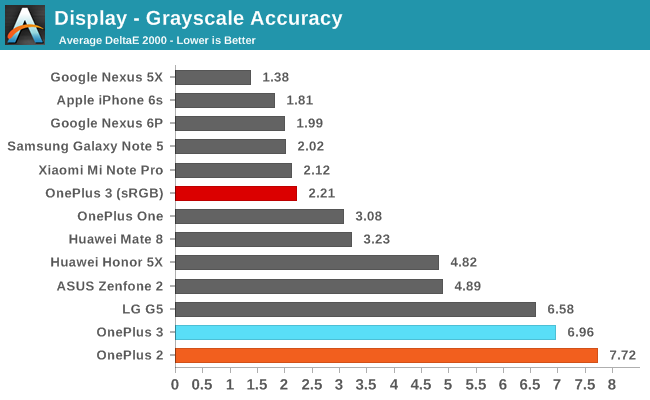
Greyscale accuracy with the sRGB mode enabled is a huge improvement over the standard display mode. The CCT average is slightly below target, but only by a tiny amount. My only complaint is that the RGB balance with the whitest shades is shifted too far toward red, and it would be good to tweak this a tiny bit to make sure 100% white is properly balanced so that the display doesn't have any sort of warm cast on webpages and in Material Design applications. Even with that, the error levels for each individual shade of grey are all at or below three, which is what we're targeting. With these changes the OnePlus 3 goes from being one of the worst displays on record to one of the best, and that's a great thing to see.
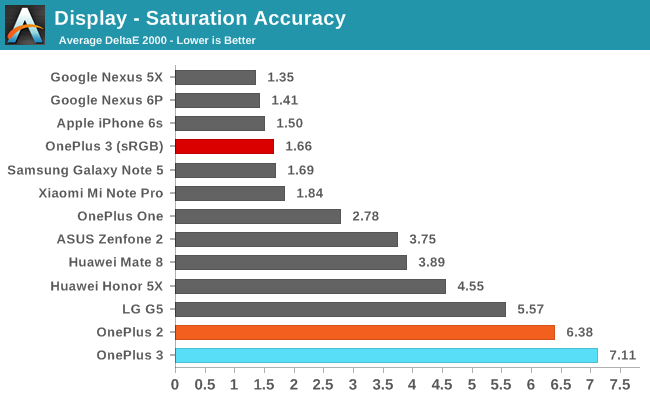
I was originally concerned that it might be too late to properly fix the OnePlus 3's display once phones had shipped, as there's a degree of variance from display to display. However, it appears that the displays, while inaccurate, were defined well enough that OnePlus knew what to tweak to constrain them to sRGB. In the saturation sweep test you can see that only two error values go slightly above three, with the rest being comfortably below.
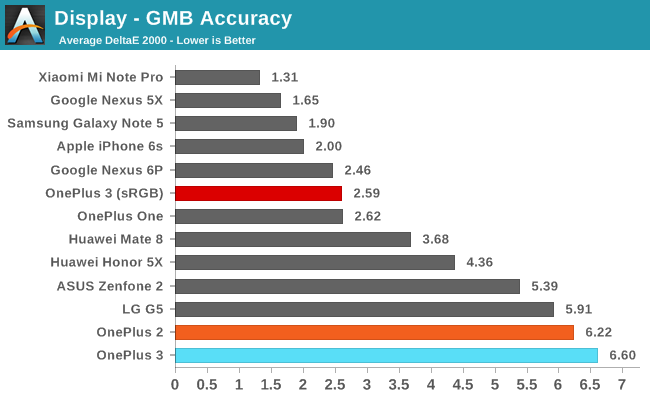
With great greyscale and saturation rendering you're usually set for accurate color mixture rendering. With its sRGB mode enabled the OnePlus 3 does a great job of rendering the colors that are part of the GretagMacbeth ColorChecker test. The error value is below our target value of three, and pushing accuracy much further doesn't bring many benefits as at this point you already can't discern the difference between the colors and their actual reference colors unless you have them sitting still beside one another.
To say that OnePlus's new sRGB mode provides a substantial improvement in display accuracy would be an understatement. The display has gone from being the most inaccurate display that I've seen in years, to being among the most accurate displays that we have on record. Gone is the ghastly blue shift, and even in the standard display mode OnePlus has toned that down significantly. The gamut matches sRGB very well, and both greyscale and color reproduction is right on target.


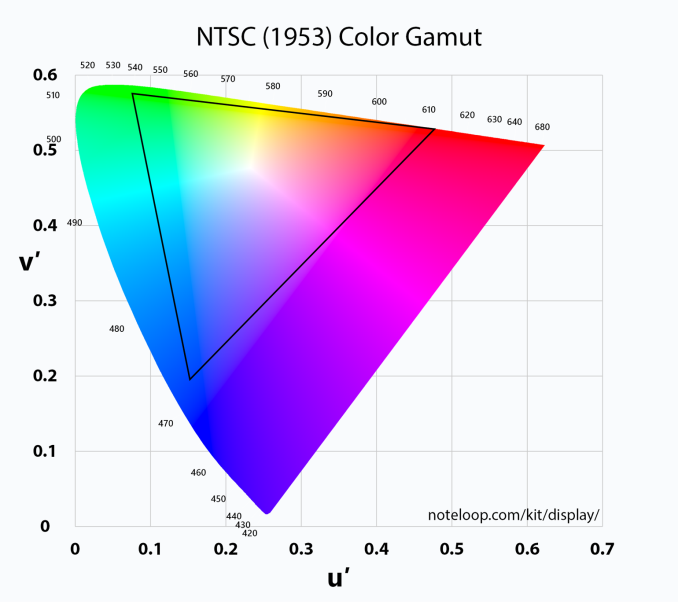
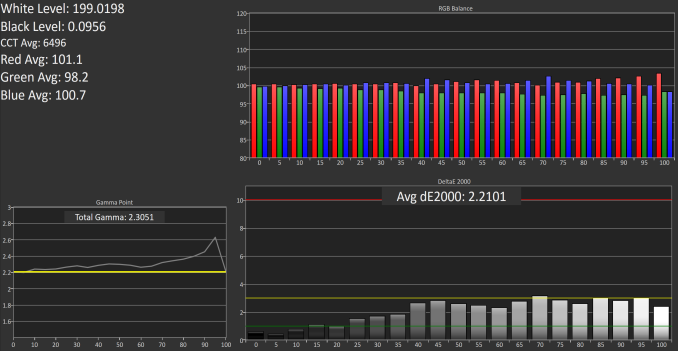

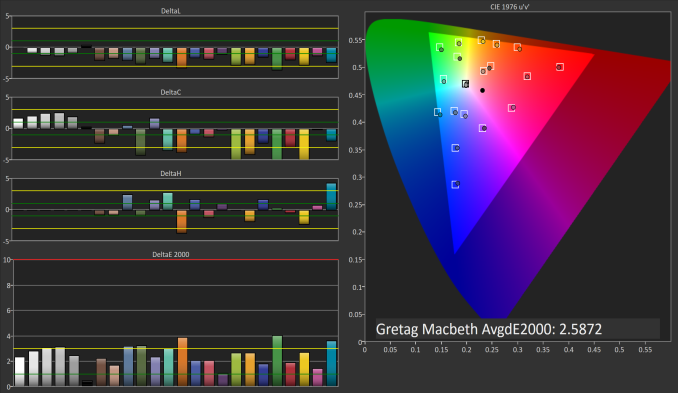








81 Comments
View All Comments
Rc1138 - Friday, July 1, 2016 - link
Great news for me too. While I'm not exactly a super picky person when it comes to display accuracy, I still find it uncomfortable to use the display with quality or calibration issues.dego - Friday, July 1, 2016 - link
would you advice an upgrade from oneplusone to oneplus3 ?Impulses - Friday, July 1, 2016 - link
Nice update, super appreciated.prathya - Friday, July 1, 2016 - link
How much did OnePlus pay you for this post ?pvdw - Friday, July 1, 2016 - link
Thanks Brandon! The OnePlus 3 looked really interesting till those horrid colour issues. If this fix makes it through to release firmware soon this phone will make it onto my shortlist.Vinap - Friday, July 1, 2016 - link
I bought one plus 2 and have so many issues...for past 6 weeks I am trying to get some support fro the company. Customer service is awful...I feel as if my hard earned money is due the drain..zodiacfml - Sunday, July 3, 2016 - link
good. that was quick. for mw though, i have to wait and see for this year's Nexus' and Google's phone.Having the latest version of Android just feels very good value to me, almost compulsory.
PaulD87 - Monday, July 4, 2016 - link
Since I ordered the phone, I watched all reviews, and everyone said the screen was not top of the line but not that bad either.That was until I watched a review on Youtube and the reviewer said the display had issues and referred to this article. And you completely bashed it.
Now it makes me wonder, since you are reviewing a piece of hardware, how a few software tweaks, made the difference between one of the worst to one of the best displays tested lately.
I strongly doubt everyone that referred to the original Youtube review will also refer to this one, some of the damage done to the image of the phone will be permanent.
10basetom - Wednesday, July 13, 2016 - link
Very interesting, as I just read another review that had a completely different opinion on the sRGB profile:"The sRGB mode that comes with the OxygenOS 3.2 update can be enabled in the developer options. However, we would not recommend doing this. As the measurements using maximum screen brightness show, the color reproduction is then very good, but the image looks very warm in dimmed screen brightness. Furthermore, it is no longer possible to counter this via the color balance slider since it is then disabled. The reduction of the reproducible color space is the worst thing: Up to 100 percent are still covered ex-factory, but paradoxically only about 70 percent is covered in sRGB mode. The AdobeRGB color space coverage even drops from 89 to almost 45 percent. The way things are now, the sRGB mode is just a sham. However, the factory calibration is absolutely acceptable and well-implemented."
Source: http://www.notebookcheck.net/OnePlus-3-Smartphone-...
Justin Berta - Thursday, July 28, 2016 - link
Never had a problem with their phones, but I did deal with customer service when I needed a refund. Response was quick and resolved. They may have been bad in the early days, but OnePlus really impressed me.